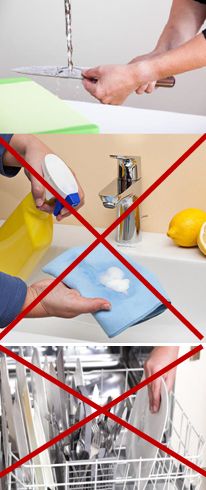
Easter Stock Arrived
European Fine Foods, Home & Garden, Bath & Body Brands - Subscribe to our Newsletter for Seasonal Updates
Care & Handling
1. Always wash the knives by hand in order to protect the material and maintain long-lasting sharpness. Before first using our knives, rinse them with hot water.
2. Immediately after each use, clean the blades under running water and dry them with a soft cloth. Do not use aggressive cleaning agents.
3. Rinse aggressive substances such as lemon juice immediately after use.
4. Never place the blades in the dishwasher. This affects not only the material, but also the sharpness of the cutting edge
5. Knives with natural wood handles should not stay too long in the water. Occasionally, oil the handle with some neutral oil (best: camellia oil).
6. Never use glass or granite cutting boards. These are easy to maintain, but also ruin the cutting edge even with the hardest steel. Use only wooden boards (preferably head wood) or plastic cutters with medium strength.
7. Proper cutting technique also maintain your knife edge. The proper cutting motion is a „locomotive“ motion, pushing the knife forward and down as you cut through the food, then pulling the knife up and back towards you to position it for the next cut.
8. When storing the knives, make sure that the blade never comes into contact with other metallic objects. This prevents damage to the cutting edge. Keep the knives in a blade protector, either in a knife block, on a wall magnetic board or in the Japanese blade molds.
9. The blades are absolutely not suitable for cutting bones (including of fish) or frozen foods.

Honing & Sharpening
To maintain the life of your blade and for optimal performance, it’s important to keep your knife honed. But remember that there’s a big difference between honing and sharpening. Honing maintains your blade. It simply realigns the micro edge of your blade to give you the best performance possible—until your knife is ready for sharpening. Sharpening actually removes metal from the blade, putting a fresh edge on the knife. If you hone regularly, you’ll cut down on the need for sharpening and extend the life of your knife.
Grinding instructions
Before use, the whetstone should be completely soaked in water for about 10 minutes. Please make sure that a light film of water is always visible on the surface of the stone during grinding. By doing this you ensure the knife edge is sufficiently cooled. Double-edged blades
a. Lay one side of the blade onto the whetstone
b. Start at the blade tip. Pull the knife at an angle of about 15 ° over the whetstone, whilst moving the blade with light pressure toward and away from your body. Repeat this process until you feel a fine burr.
c. Turn the knife over and continue with sharpening the other side of the blade, as described above. Make sure that you use the same number of strokes on both sides. It is also important that the angle is always kept the same so that you end up with a symmetrically sharpened blade.
d. Rinse knife and whetstone carefully in hot water.
Single-edged blades
a. First, lay the partially whetted side of the blade onto the grindstone.
b. Start at the blade tip. Pull the knife at an angle of 45 °over the whetstone, whilst moving the blade with light pressure toward and away from your body. Repeat this process until you feel a fine burr.
c. Turn the knife over. Now lay the hollow-ground side of the blade flat on the grindstone and continue with sharpening - but only about 1/10 as much as when sharpening the knife's other side.
d. Rinse both the knife and whetstone carefully in hot water.
Warranty Policy
We are proud to guarantee that each Kai chef's knife manufactured in Japan leaves in absolute faultless condition.
In case a product shows any faults in original material, construction, or workmanship it will either be replaced or repaired. If you choose to replace it, we cannot return the old one.
Normal wear and mistreatment are excluded from this warranty (blade chips, tip damage, scratches)
Mistreament
Mistreatment includes using the wrong cutting technique as well as cutting bones, joints, or frozen foods. Hard cutting surfaces as marble or glass are also inappropriate. Your knives should also not be stored in a drawer without protection or put in the dishwasher. If the tip of the knife is bent as a result of inappropriate use or accidental handling, Kai can attempt to repair and/or reshape the edge of your knife. If our attempt is unsatisfactory or unsuccessful, Kai is not responsible for replacing the knife. Maintaining the edge of your knife is considered normal care and is the responsibility of the owner.
Rust
Stainless steel knives can still develop rust. Rust is caused by moisture left on the blade. It is not a manufacturing defect and not covered by warranty.
Fading signs
Fading signs of wear are not defects, they are caused by normal use. The warranty does not guarantee the esthetics of a product after it has been used.